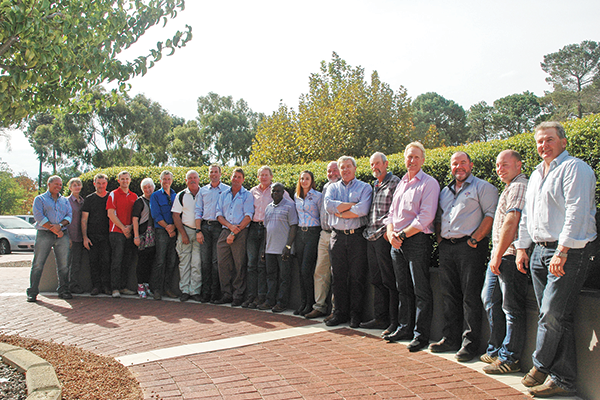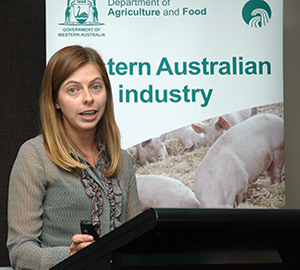AN insightful reflection by animal nutritionist Tony Edwards of ACE Livestock Consulting on how the past 30 years of research has benefited pork producers set the scene for a vibrant 2016 Pig Day Out, attended by about 100 people and hosted by West Australian Pork Producers’ Association and the Department of Agriculture and Food, WA on Friday, April 8 at Technology Park, Bentley.
Quoting fascinating statistics, such as the rise in average daily weight gain from 450g in the 1970s to 700g today; the increase in number of pigs produced per sow, per year from 16 to 24; and kilograms of meat produced per sow per year from 960kg to 1800kg, Mr Edwards noted that pork production technology had advanced rapidly. “However, we need to constantly improve to remain competitive and the main driver of improvements will be scientific research,” Mr Edwards said.
“There is still much more to uncover and we are currently well short of the biological potential of the pig.” Addressing the issue of where Australia sits in the global pig and pork productivity and profitability stakes, Pork CRC CEO Roger Campbell said the Australian industry was currently one of the most profitable and vibrant in the world. “I expect growth based on longer-term contracts, which will reflect demand for high-integrity Australian pork and I also think there’s still plenty of money on the table for Australian pork producers if they can work on improving reproduction, carcass weights, feed efficiency and product differentiation,” Dr Campbell said.
Global trends were the use of post-cervical artificial insemination and set time AI, fatty acids in lactation, tryptophan levels in lactation diets and large pellets in creep and weaner feeds. Other R&D speakers in the morning session at WAPPA Pig Day Out 2016 included:
- Dr Jae Kim, DAFWA: dietary use of tryptophan and methionine;
- Dr Megan Trezona, DAFWA: outdoor pig production; and
- Karen Moore, DAFWA: feeds to control fat deposition after second dose of Improvac.
The afternoon session began with an entertaining biosecurity training session for producers and transporters by veterinarian Kim Nairn of Portec Veterinary Services.
Dr Nairn said pig manure posed the greatest disease risk and transporters, producers and processors needed to be vigilant in ensuring faecal matter wasn’t transferred. His take-home message for producers was: “Go home after today and take a good look at all biosecurity measures on your farms.”
Darryl D’Souza of Australian Pork Limited sparked spirited debate when he updated the meeting on the Australian Pork Industry Quality Program and APL’s ‘Shaping our Future’ program in relation to gestation stall free. Dr D’Souza said APL’s aim was to keep regulators on its side and to defend its stance on farrowing crates and fresh pork imports.
In the final session, Murdoch University presentations included:
- Prof John Pluske: suppressing voluntary feed intake of finisher pigs;
- Jeremy Ayre: microalgae to treat piggery anaerobic digestion effluent;
- Samantha Sterndale: reducing stress through nutrition to improve pig growth; and
- Ingunn Stensland: supplements to improve intestinal health in E.coli-infected weaners.
The last speaker was Dr Kim Nairn, this time wearing his ‘producer hat’ as he reflected on how his Peel Pork Piggery survived the devastating January Yarloop bushfire.
Pig Day Out sponsors were Pork CRC, APL, MSD Animal health and Elanco. Addressing a brief WAPPA general meeting at the start of Pig Day Out, WAPPA president Dawson Bradford commended WA producers and researchers on how they collaborated for the benefit of the industry and how this needed to continue as DAFWA transitioned and the onus of R&D in WA increasingly moved onto industry.
Rob Wilson updated developments relating to Pork Innovation WA, an incorporated association expected to attract initial transition funding from DAFWA. PIWA has been awarded a grower group R&D grant of $375,000, which will be administered by DAFWA and cover all aspects of free range pork production in WA. Dr Wilson also announced that the Pork CRC had awarded an honours project, through Murdoch University, to be associated with that free range work.
PIWA executive management committee members are Dr Rob Wilson (chair), Ron Penn (Craig Mostyn Group), David Plant (Milne Agrigroup), John Pluske (Murdoch University), Neil Ferguson (Westpork) and Jan Cooper (WAPPA).
WA’s pork industry employs about 1700 full and part-time workers and more than $50 million has been invested in housing and production systems during the past five years to meet new guidelines for sow housing and production efficiency.
WAPPA executive officer Jan Cooper encouraged members at the general meeting to further engage with her in shaping WAPPA’s direction by attending WAPPA’s annual general meeting and dinner to be held on Friday, August 12.
WAPPA’s executive committee comprises Dawson Bradford (president) of Popanyinning, Graeme Dent (vice president) of Cuballing, Torben Soerensen (treasurer) of GD Pork , Dean Romaniello of Craig Mostyn Group and Emalyn Loudon, consultant to the pork industry.
www.wappa.com.au















